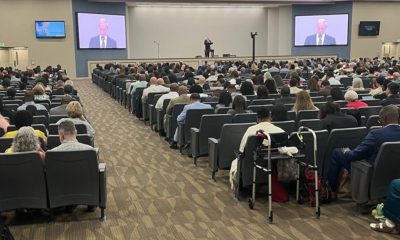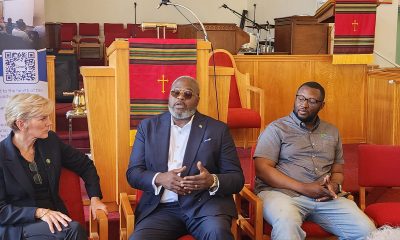Education
MPS students promote peace through United Nations world fair
MILWAUKEE TIMES WEEKLY — Students from 13 MPS schools took charge of the UWM Panther Arena on April 11 to share their knowledge of countries across the globe. Student displays included photos, maps, and important facts about each country and culture. Projects dug deep to explore the strengths and challenges of each nation and the role each country plays in its region or continent. The world fair was the culmination of the year’s United Nations Schools of International Learning (UNSIL) program, which is implemented in 13 MPS schools.
By The Milwaukee Times Weekly
Students from 13 MPS schools took charge of the UWM Panther Arena on April 11 to share their knowledge of countries across the globe. Student displays included photos, maps, and important facts about each country and culture. Projects dug deep to explore the strengths and challenges of each nation and the role each country plays in its region or continent. The world fair was the culmination of the year’s United Nations Schools of International Learning (UNSIL) program, which is implemented in 13 MPS schools.
The highlight of the day was a series of student performances that included African drumming, traditional songs, and a multicultural fashion show. Students had the chance to show pride in their roots by wearing traditional dress from their cultures. Schools in the UNSIL program serve students from diverse nationalities, languages, and cultures. Students at these 13 schools speak 35 different languages.
Through the UNSIL curriculum, elementary and middle school students are researching and learning about countries and world issues. The program promotes cultural awareness and develops skills needed in a global setting. Each year of the program expands upon the previous year’s work and moves students along a spectrum from studying to analyzing to taking action.
• Grade 4 – Research on countries
• Grade 5 – Technology project on the organizations and committees of the UN
• Grade 6 – Global sustainability goals position paper
• Grade 7 – Public service announcements on the UN Agencies and priority goals
• Grade 8 – Service learning project
At a time when immigration is a sensitive topic, a $100,000 grant through the Greater Milwaukee Foundation’s Annette J. Roberts & Joan R. Robertson Fund for World Peace, World Law, and Peace Education, secured by the Milwaukee Public Schools Foundation, has helped create and support the United Nations Schools of International Learning curriculum in thirteen MPS schools: Academy of Accelerated Learning, Bethune Academy, Burbank School, Garland School, Humboldt Park School, Milwaukee Academy of Chinese Language, Parkview School, Milwaukee German Immersion, Story School, Gilbert Stuart School, Victory Italian Immersion School, U.S. Grant School, and Zablocki School. MPS expanded programming this year to include 4th through 8th grade students. When first instituted in MPS schools in 2016, the UNSIL program was offered in grades 4 and 6 at nine schools.
This article originally appeared in the Milwaukee Times Weekly.
California Black Media
New California Laws Require High School Classes on Drug Education, Financial Literacy and Ethnic Studies
Last week, California became the 26th state to require high school seniors to pass courses focused on finance literacy, coming behind recently added ethnic studies prerequisite and a health class requirement focused on the dangers of fentanyl use. The senior class of 2031 will be the first group of students to take the mandatory financial literacy course. California school districts are required to implement Assembly Bill 2927, authored by Assemblymember Kevin McCarty (D-Sacramento), at the beginning of the 2027-2028 academic year.

By Bo Tefu
California Black Media
Last week, California became the 26th state to require high school seniors to pass courses focused on finance literacy, coming behind recently added ethnic studies prerequisite and a health class requirement focused on the dangers of fentanyl use.
The senior class of 2031 will be the first group of students to take the mandatory financial literacy course. California school districts are required to implement Assembly Bill 2927, authored by Assemblymember Kevin McCarty (D-Sacramento), at the beginning of the 2027-2028 academic year.
The bill works hand-in-hand with newly approved Assembly Bill 2429, authored by Assemblymember David Alvarez (D-San Diego). That law requires students to take health classes that discuss the dangers of fentanyl use and illegal drugs commencing in the 2026-2027 school year.
Both bills require high school seniors to complete the designated coursework during any semester between the ninth and 12th grades. High school students in charter schools are also required to complete the state-mandated coursework. Under this law, local educational agencies will impose the required courses using state-mandated local programs.
McCarty said that the financial literacy classes will prepare students for the future and empower them to make smart money decisions throughout life.
“It’s such an important life skill,” he said. “The stressors that young people face today — especially student loans, renting, buying a house, credit cards all those things are so critically important. And if you fall behind, the consequences have a serious impact later in life.”
Unlike the bill on financial literacy that imposes classes as a graduation requirement, the bill on health education allows school districts to choose if health classes are a graduation prerequisite.
Alvarez said that health education can help address the state’s fentanyl epidemic, specifically among the youth.
“I think it’s important… that we share facts with young people, especially these days as they rely more and more on social media with misinformation,” said Alvarez.
“There’s still no better-trusted source than our schools for students and for families to receive the information that they need in order to make better decisions and better choices,” he continued.
Gov. Gavin Newsom said the state needs to help prepare young people in a statement backing the bills.
“Saving for the future, making investments, and spending wisely are lifelong skills that young adults need to learn before they start their careers, not after,” the Governor said in statement backing the education bills.
Starting in the 2025-2026 academic year, the state will also require high school seniors to take an additional one-semester course on ethnic studies.
California Black Media
November Election: Calif. Voters to Decide on $10 Billion Bond for Public Education Upgrades
Last week, the California State Legislature approved a $10 billion bond proposal to modernize and repair K-12 schools and community colleges statewide. The education bond measure, Assembly (AB) Bill 247, will appear on this year’s November ballot. AB 247 aims to upgrade school buildings, allocating $8.5 billion to public schools and $1.5 million to community colleges across California.

By Bo Tefu
California Black Media
Last week, the California State Legislature approved a $10 billion bond proposal to modernize and repair K-12 schools and community colleges statewide.
The education bond measure, Assembly (AB) Bill 247, will appear on this year’s November ballot.
AB 247 aims to upgrade school buildings, allocating $8.5 billion to public schools and $1.5 million to community colleges across California.
Authored by Assemblymember Al Muratsuchi (D-Torrance), the measure was authored in collaboration with Assemblymembers Mike Fong (D-Alhambra), and Lori Wilson (D-Suisun City), and Senators Steve Glazer (D-Contra Costa) and Josh Newman (D-Fullerton).
Supporters of the proposition point out that schools in California are over 50 years old, raising safety concerns among community and school leaders. The education bond will provide matching dollars to K-12 school districts based on local priorities and it calls for monitoring spending for local taxpayer accountability.
“California urgently needs a statewide school bond to repair dilapidated and unsafe school facilities and to invest in our children to meet 21st-century educational and workforce needs,” said Muratsuchi, an author of the education bond proposal.
Since 1998, the state has been providing $54 billion in education bonds for K-12 schools and institutions of higher education. Voters approved the last successful bond, Proposition 51, during the 2016 November election. That proposition has provided K-12 schools with $7 billion and community colleges with $2 billion for repairs and construction to improve safety.
However, some school district officials are concerned that funds from state and local bonds mostly benefited affluent districts, leaving rural districts disadvantaged.
A report by the Public Policy Institute of California stated that it is easier for the state to match funds from the district in wealthier areas. The report stated that voters in affluent areas are more likely to approve bonds making it easier to raise funds since their property values are higher.
Public Advocates, a nonprofit law firm, threatened to sue the State claiming that the bond system is unconstitutional.
“The Legislature is shooting itself in the foot. What they’ve proposed will only undermine support from voters,” said John Affeldt, an attorney who supports the bill. “But technically they still have time to fix this.”
State officials, on the other hand, remain optimistic about the outcome of the education bond during this year’s November election.
Black History
Betty Harris: Inventor of Spot Test That Revolutionized Chemical Detection
Our accomplishments never cease to amaze me. Imagine being a scientist who can detect hidden chemicals with just a simple test. Here’s another hidden gem. Dr. Betty Harris is a brilliant scientist and inventor known for her work in chemistry. She was born on July 29, 1940, in Louisiana. From a young age, Betty was fascinated by science. She loved to learn how things worked and always asked lots of questions. Her passion for science led her to become a chemist.

By Tamara Shiloh
Our accomplishments never cease to amaze me. Imagine being a scientist who can detect hidden chemicals with just a simple test. Here’s another hidden gem.
Dr. Betty Harris is a brilliant scientist and inventor known for her work in chemistry. She was born on July 29, 1940, in Louisiana. From a young age, Betty was fascinated by science. She loved to learn how things worked and always asked lots of questions. Her passion for science led her to become a chemist.
By 1961, aged just 19, she had graduated from Southern University in Baton Rouge with a chemistry degree.
She did her research at Los Alamos National Laboratory, New Mexico, where she worked in the areas of hazardous waste treatment and environmental remediation as well as explosives chemistry. Areas of focus included explosives detection, synthesis and characterization of insensitive high explosives and sensitivity of weathered high explosives.
Her invention, a spot test for TATB, represents a significant advancement in the detection of this crucial but stable explosive compound.
TATB stands for 1,3,5-triamino-2,4,6-trinitrobenzene. It’s a type of explosive that is very stable and safe to handle, making it important for various safety applications. TATB is used in explosives because it doesn’t explode easily under heat or shock, which means it’s safer to store and use.
Harris invented a special test called a “spot test” to detect TATB. Before her invention, finding TATB in materials was difficult and time-consuming. Her spot test made it quick and easy to detect this important chemical.
The spot test developed by Harris is a simple yet powerful method that involves a few straightforward steps. A small sample of the material in question is obtained. The sample is treated with a special chemical solution formulated by Harris. If TATB is present in the sample, the solution undergoes a color change, providing a clear and immediate indication of its presence.
Harris’s spot test is important for several reasons. The test helps ensure that explosives are safe to handle and store. By detecting TATB quickly, accidents can be prevented. It is easy to use and provides fast results, saving time and resources.
Inventions like Harris’s help science to progress by making it easier to work with important chemicals.
Her contributions extend beyond her scientific achievements. She is a passionate advocate for education and has been a mentor to countless young scientists, particularly encouraging girls and African American students to pursue careers in Science, Technology, Engineering and Math (STEM) fields.
Her dedication to fostering the next generation of scientists has earned her numerous accolades and respect in the academic community.
Harris still lives in New Mexico.
-

 Arts and Culture3 weeks ago
Arts and Culture3 weeks agoRooted in Tradition: The Intricate History of Black Hair Braiding
-

 Bay Area4 weeks ago
Bay Area4 weeks ago“I Will Not Be Bullied,” Says Oakland Mayor Sheng Thao
-

 Bay Area2 weeks ago
Bay Area2 weeks agoPG&E Increases Rates While Bay Area Households Are Struggling to Stay Afloat
-

 Business3 weeks ago
Business3 weeks agoGov Newsom: Raising Fast Food Minimum Wage to $20 Pays Off as Jobs Multiply in Industry
-

 Activism4 weeks ago
Activism4 weeks agoOpponents of Mayor Sheng Thao Are Calling on Her to Resign Following FBI Raid
-

 Community1 week ago
Community1 week agoHundreds Come to Jehovah’s Witnesses’ Assembly Hall for Three-Day Program of ‘Good News’ in Fremont
-

 Bay Area2 weeks ago
Bay Area2 weeks agoJuneteenth Mass Shooting Suspect Charge with Multiple Counts of Felony Assault by Alameda County DA Pamela Price
-

 Activism4 weeks ago
Activism4 weeks agoOakland Coliseum Sale to AASEG: A Model for Community Development and Inclusion






















































